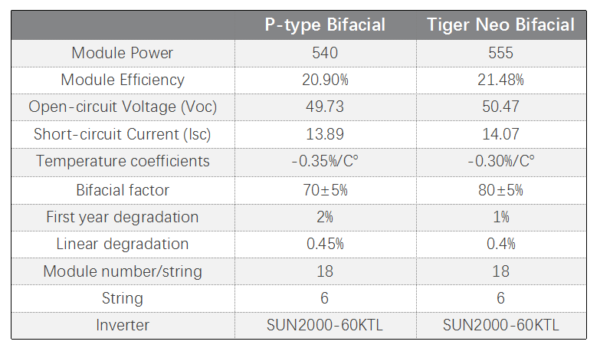The study is devoted to the assessment of PERC bifacial (JKM540-72HL4-BDVP) and TOPCon bifacial modules(JKM555N-72HL4-BDV).The data was collected during four months from July to October. The influence of irradiance on the temperature, bifacility, and efficiency of modules was studied. The results show that the efficiency of the PERC modules decreases with rising temperature in July and August especially; however, the efficiency of the N-Topcon modules is more stable. The higher bifacility of N-Topcon modules attributes a lot to the energy yield equipped with a 1P tracker and on a white painted ground.
Table 1. The specification of PV modules

Methods: Experimental Setup and Data Acquisition
The solar power plant on which the investigations were carried out is located in Ningbo (latitude 29 °52’ N, longitude121°32’ E). Its total installed capacity equals 118.26 KWp.108 pcs P-PERC (144 half-cut cells in 182”) as comparison group and 108 pcs N-Topcon bifacial modules (144 half-cut cells in 182”) as experimental group were mounted on 1P tracker on a commercial rooftop. The installation is grid connected. The rows of panels are 5 m apart to avoid near shading and lowering the module output. All types modules are placed vertically. The modules are installed 1.2 m above the white painted ground(Albedo:40%~)ground. The PASAN Sun simulator measured the front and rear sides' electrical characteristics. The outdoor energy generation was measured by DC meters in a 1-min interval. All the installed modules were new and the whole plant started to operate at the July 02 of 2022. The energy yield performance of TOPCon, PERC bifacial PV were revealed and systematically compared.
The modules are connected to the grid using two inverters model SUN2000-60KTL-M0 with nominal AC power 60 kW, characterized by the maximum efficiency of 98.6%. The inverter is equipped with 6 maximum power point trackers (MPPT) for 60kW inverter. Each MPPT is connected to 18 modules. The DC and AC electric power registered by inverters as well as solar irradiance and module temperature measurements were recorded every 5 min. by the central data logging computer to achieve synchronous data collection.
Results:
The solar plant under investigation is located in the Subtropical monsoon climate which is characterized by significant differences between the warm and cold parts of the year. The 2022 was a sunny summer with high solar irradiation and higher temperature in comparison to the previous years. Starting from July, when the irradiance is about 1226.5kwh/m2/year ,the ambient tempeature and the back PV module surface temperature reaches maximum 40 °C and 65.9 °C respectively. With increase of irradiance, the accompanying module temperature growth is observed. High irradiance conditions result in the increase of the module temperature because of air temperature growth and direct heating of the modules surface. The rise of module temperature is the reason for efficiency drop in the case of PERC technologies. This kind of changes is not observed for the N-Topcon.
Conclusion:
The harvested energy of advanced TOPCon bifacial modules has been proved in the field through this experimental study on the energy yield performance of the TOPCon bifacial compared to PERC bifacial PV modules in the east part of China, Zhejiang province.The experimental results have proven that the energy yield performance of TOPCon bifacial modules is up to 8.9% higher than that of the PERC modules.
